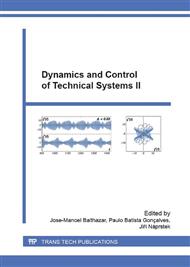[1]
S. Ostlund, D. Randt, J. Sethna and E. Siggia: Universal properties of the transition from quasiperiodicity to chaos in dissipative systems, Physica D, 8 (1983), pp.303-342.
DOI: 10.1016/0167-2789(83)90229-4
Google Scholar
[2]
P.S. Linsay and A.W. Cumming: Three-frequency quasiperiodicity, phase locking, and the onset of chaos, Physica D, 40 (1989), pp.196-217.
DOI: 10.1016/0167-2789(89)90063-8
Google Scholar
[3]
N.V. Stankevich, J. Kurths and A.P. Kuznetsov: Forced synchronization of quasiperiodic oscillations, Commun Nonlinear Sci Numer Simulat, 20 (2015), pp.316-323.
DOI: 10.1016/j.cnsns.2014.04.020
Google Scholar
[4]
J.A. Glazier and A. Libchaber: Quasi-periodicity and dynamical systems: An experimentalist's view, IEEE Transactions on circuits and systems, 35 (1988), pp.790-809.
DOI: 10.1109/31.1826
Google Scholar
[5]
L. Titarchuk: Effects of resonance in quasiperiodic oscillators of neutron star binaries, Astrophysical Journal Letters, August 2002, pp.1-11.
Google Scholar
[6]
D.T. Mook, N. HaQuang and R.H. Plaut: The influence of an internal resonance on nonlinear structural vibrations under combination resonance conditions, Jour. Sound and Vibration, 104 (1986), pp.229-241.
DOI: 10.1016/0022-460x(86)90265-8
Google Scholar
[7]
G. Kerschen, A.F. Vakakis, Y.S. Lee, D.M. McFarland, J.J. Kowtko and L.A. Bergman: Energy transfers in a system of two coupled oscillators with essential nonlinearity: 1: 1 resonance manifold and transient bridging orbits, Nonlinear Dynamics, 42 (2005).
DOI: 10.1007/s11071-005-4475-3
Google Scholar
[8]
A.H. Nayfeh: Parametric excitation of two internally resonant oscillators, Jour. Sound and Vibration, 119 (1987), pp.95-109.
DOI: 10.1016/0022-460x(87)90191-x
Google Scholar
[9]
L.D. Zavodney and A.H. Nayfeh: The response of a single-degree-of-freedom system with quadratic and cubic nonlinearities to a fundamental parametric resonance, Jour. Sound and Vibration, 120 (1988), pp.63-93.
DOI: 10.1016/0022-460x(88)90335-5
Google Scholar
[10]
P.F. Pai: Time-frequency analysis for parametric and non-parametric identification of nonlinear dynamical systems, Mechanical Systems and Signal Processing, 36 (2013), pp.332-353.
DOI: 10.1016/j.ymssp.2012.12.002
Google Scholar
[11]
A.H. Nayfeh and A.E.S. Jebril: The response of two-degree-of-freedom systems with quadratic and cubic nonlinearities to multifrequency parametric excitations, Jour. Sound and Vibration, 115(1987), pp.83-101.
DOI: 10.1016/0022-460x(87)90493-7
Google Scholar
[12]
A.J. Lichtenberg and M.A. Lieberman: Regular and Chaotic Dynamics, Springer, New York, (1992).
Google Scholar
[13]
C. Grebogi, E. Ott and J.A. Yorke: Attractors on an N-torus: quasiperiodicity versus chaos, Physica D, 15 (1985), pp.354-373.
DOI: 10.1016/s0167-2789(85)80004-x
Google Scholar
[14]
J. N´aprstek and C. Fischer: Auto-parametric semi-trivial and post-critical response of a spherical pendulum damper, Computers and Structures, 87 (2009), pp.1204-1215.
DOI: 10.1016/j.compstruc.2008.11.015
Google Scholar
[15]
J. N´aprstek and C. Fischer: Types and stability of quasi-periodic response of a spherical pendulum, Computers and Structures, 124 (2013), pp.74-87.
DOI: 10.1016/j.compstruc.2012.11.003
Google Scholar
[16]
J. N´aprstek and C. Fischer: Stability of limit cycles in autonomous nonlinear systems, Meccanica, 8 (2014), p.1929-(1943).
DOI: 10.1007/s11012-014-9899-8
Google Scholar
[17]
Yu.A. Kuznetsov: Elements of Applied Bifurcation Theory, 3rd edition, Springer, Berlin, Heidelberg, New York, (2004).
Google Scholar
[18]
J.C. Ji: Non-resonant Hopf bifurcations of a controlled van der Pol-Duffing oscillator, Journal of Sound and Vibration, 297 (2006), PP. 183-199.
DOI: 10.1016/j.jsv.2006.03.043
Google Scholar


